ABS FORD THUNDERBIRD 2005 11.G Owners Manual
[x] Cancel search | Manufacturer: FORD, Model Year: 2005, Model line: THUNDERBIRD, Model: FORD THUNDERBIRD 2005 11.GPages: 224, PDF Size: 1.91 MB
Page 11 of 224
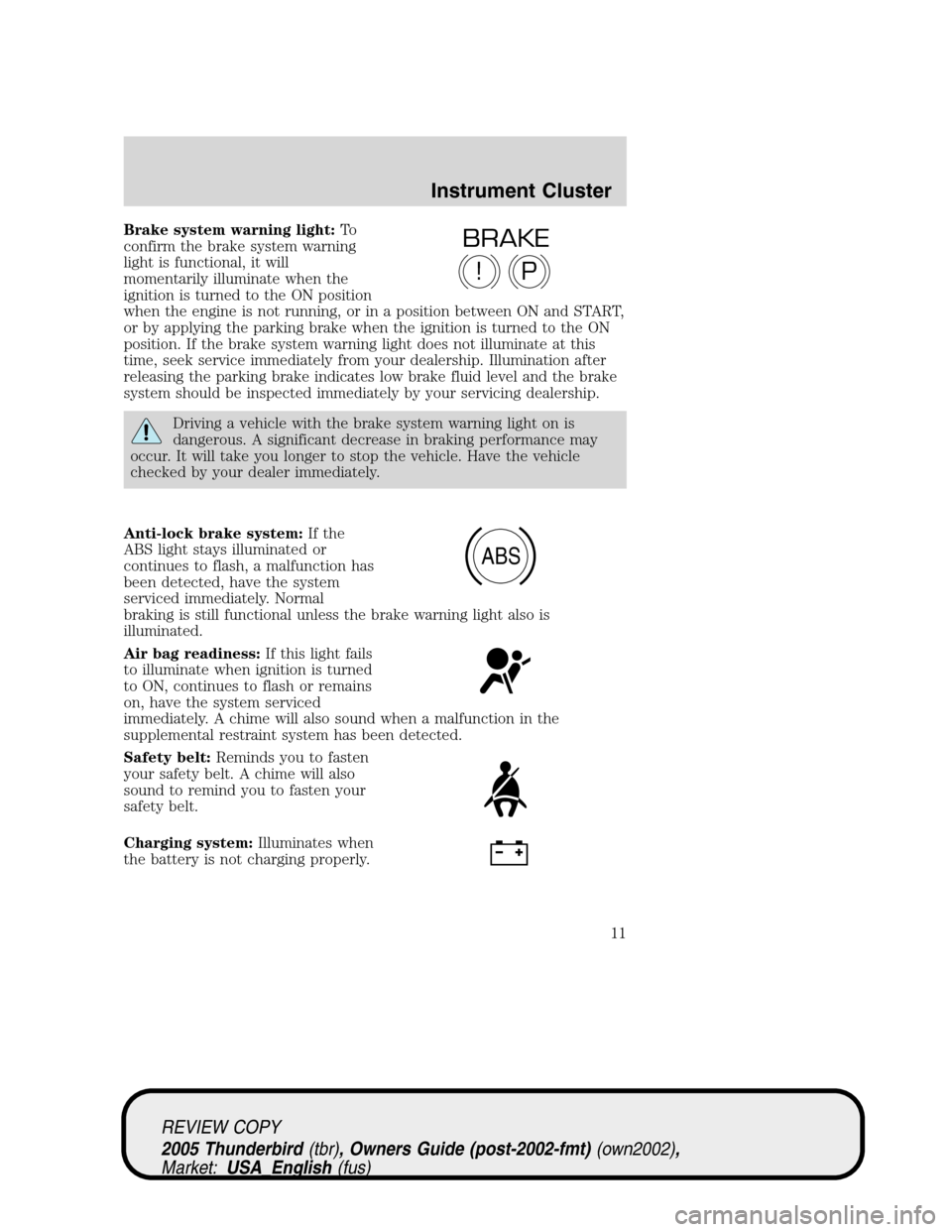
Brake system warning light:To
confirm the brake system warning
light is functional, it will
momentarily illuminate when the
ignition is turned to the ON position
when the engine is not running, or in a position between ON and START,
or by applying the parking brake when the ignition is turned to the ON
position. If the brake system warning light does not illuminate at this
time, seek service immediately from your dealership. Illumination after
releasing the parking brake indicates low brake fluid level and the brake
system should be inspected immediately by your servicing dealership.
Driving a vehicle with the brake system warning light on is
dangerous. A significant decrease in braking performance may
occur. It will take you longer to stop the vehicle. Have the vehicle
checked by your dealer immediately.
Anti-lock brake system:If the
ABS light stays illuminated or
continues to flash, a malfunction has
been detected, have the system
serviced immediately. Normal
braking is still functional unless the brake warning light also is
illuminated.
Air bag readiness:If this light fails
to illuminate when ignition is turned
to ON, continues to flash or remains
on, have the system serviced
immediately. A chime will also sound when a malfunction in the
supplemental restraint system has been detected.
Safety belt:Reminds you to fasten
your safety belt. A chime will also
sound to remind you to fasten your
safety belt.
Charging system:Illuminates when
the battery is not charging properly.
P!
BRAKE
ABS
REVIEW COPY
2005 Thunderbird(tbr), Owners Guide (post-2002-fmt)(own2002),
Market:USA_English(fus)
Instrument Cluster
11
Page 33 of 224
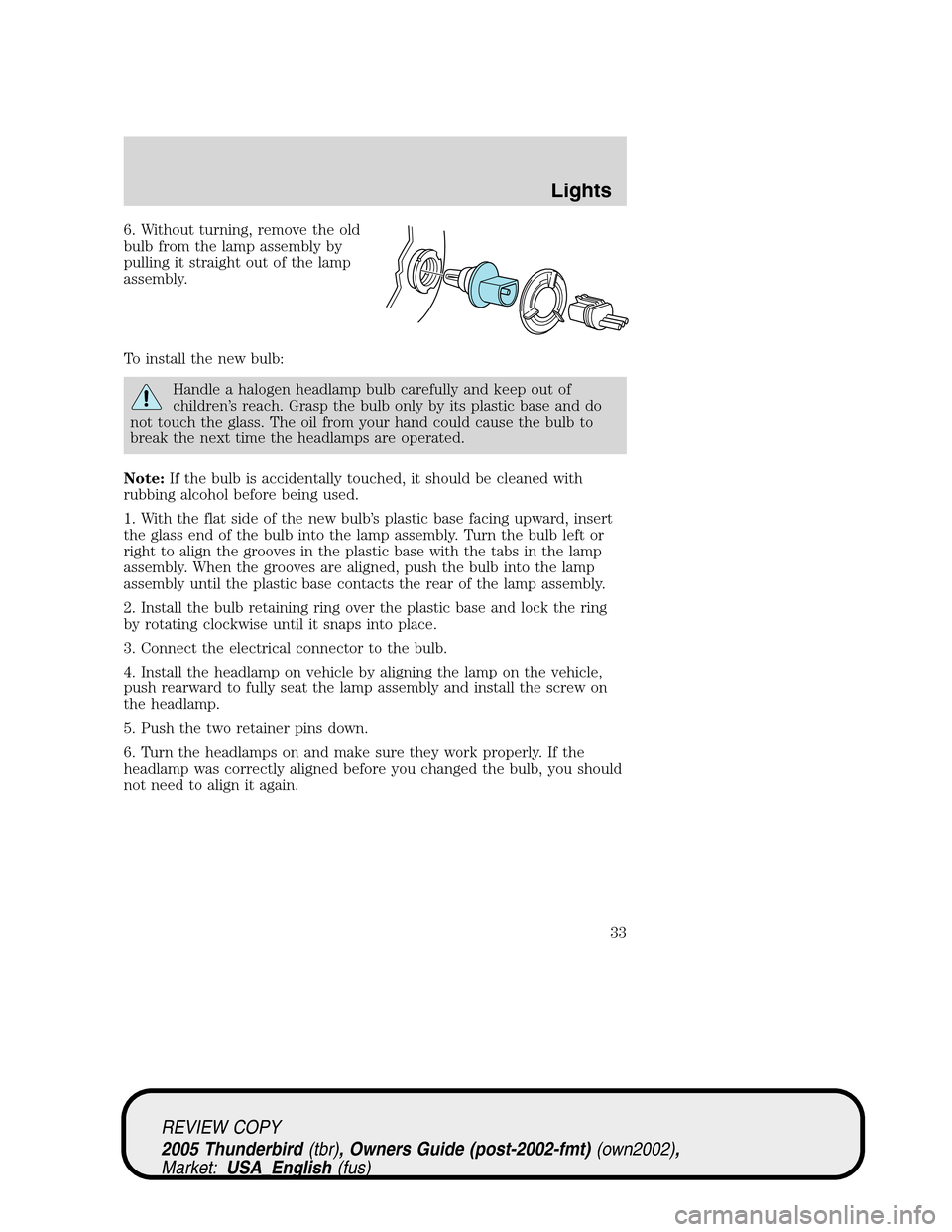
6. Without turning, remove the old
bulb from the lamp assembly by
pulling it straight out of the lamp
assembly.
To install the new bulb:
Handle a halogen headlamp bulb carefully and keep out of
children’s reach. Grasp the bulb only by its plastic base and do
not touch the glass. The oil from your hand could cause the bulb to
break the next time the headlamps are operated.
Note:If the bulb is accidentally touched, it should be cleaned with
rubbing alcohol before being used.
1. With the flat side of the new bulb’s plastic base facing upward, insert
the glass end of the bulb into the lamp assembly. Turn the bulb left or
right to align the grooves in the plastic base with the tabs in the lamp
assembly. When the grooves are aligned, push the bulb into the lamp
assembly until the plastic base contacts the rear of the lamp assembly.
2. Install the bulb retaining ring over the plastic base and lock the ring
by rotating clockwise until it snaps into place.
3. Connect the electrical connector to the bulb.
4. Install the headlamp on vehicle by aligning the lamp on the vehicle,
push rearward to fully seat the lamp assembly and install the screw on
the headlamp.
5. Push the two retainer pins down.
6. Turn the headlamps on and make sure they work properly. If the
headlamp was correctly aligned before you changed the bulb, you should
not need to align it again.
REVIEW COPY
2005 Thunderbird(tbr), Owners Guide (post-2002-fmt)(own2002),
Market:USA_English(fus)
Lights
33
Page 56 of 224
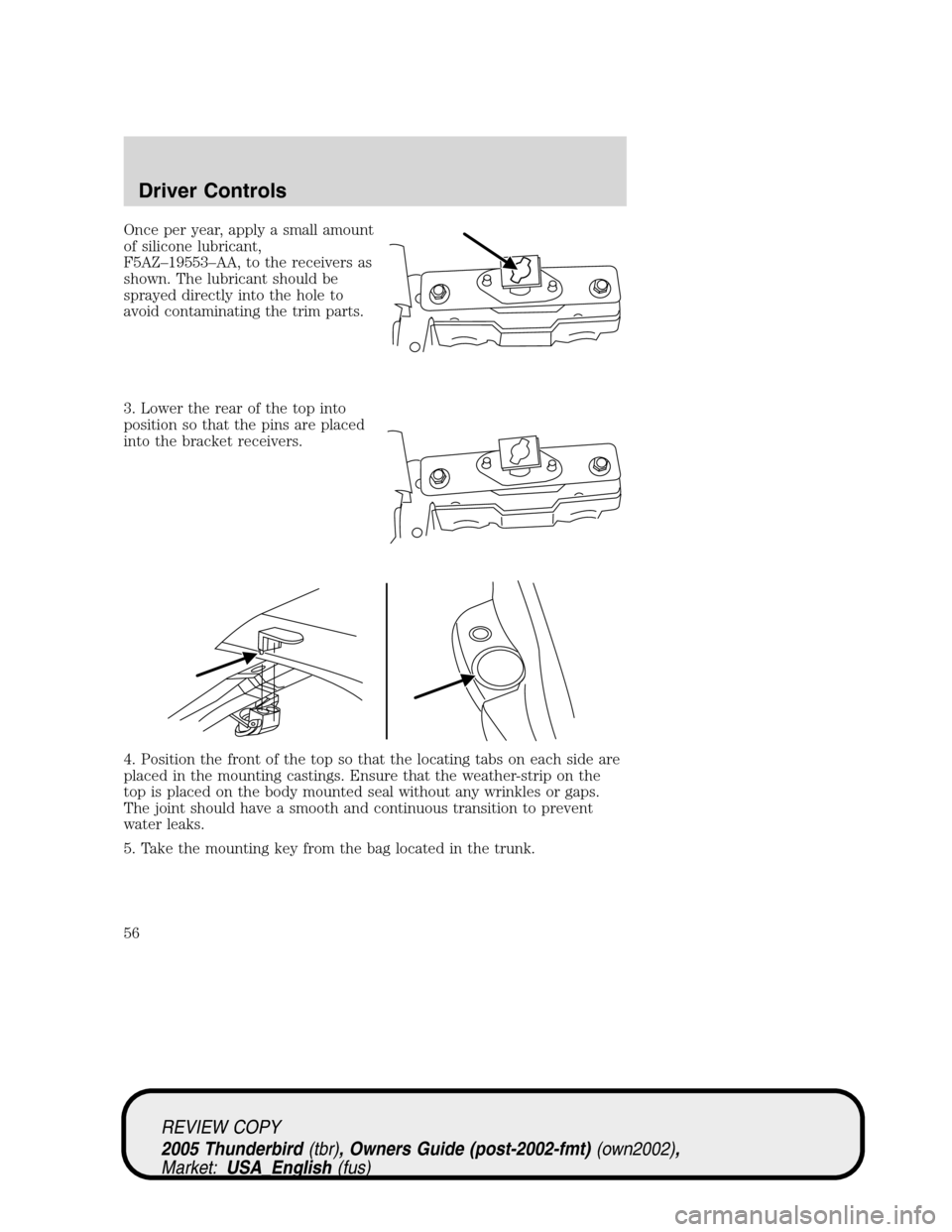
Once per year, apply a small amount
of silicone lubricant,
F5AZ–19553–AA, to the receivers as
shown. The lubricant should be
sprayed directly into the hole to
avoid contaminating the trim parts.
3. Lower the rear of the top into
position so that the pins are placed
into the bracket receivers.
4. Position the front of the top so that the locating tabs on each side are
placed in the mounting castings. Ensure that the weather-strip on the
top is placed on the body mounted seal without any wrinkles or gaps.
The joint should have a smooth and continuous transition to prevent
water leaks.
5. Take the mounting key from the bag located in the trunk.
REVIEW COPY
2005 Thunderbird(tbr), Owners Guide (post-2002-fmt)(own2002),
Market:USA_English(fus)
Driver Controls
56
Page 140 of 224

Four-wheel anti-lock brake system (ABS)
Your vehicle is equipped with an Anti-lock Braking System (ABS). This
system helps you maintain steering control during emergency stops by
keeping the brakes from locking. Noise from the ABS pump motor and
brake pedal pulsation may be observed during ABS braking and the
brake pedal may suddenly travel a little further as soon as ABS braking
is done and normal brake operation resumes. These are normal
characteristics of the ABS and should be no reason for concern.
ABS warning lamp
The ABS lamp in the instrument
cluster momentarily illuminates
when the ignition is turned on. If
the light does not illuminate during
start up, remains on or flashes, the
ABS may be disabled and may need to be serviced.
Even when the ABS is disabled,
normal braking is still effective. (If
your BRAKE warning lamp
illuminates with the parking brake
released, have your brake system
serviced immediately.)
Using ABS
When hard braking is required, apply continuous force on the brake
pedal; do not pump the brake pedal since this will reduce the
effectiveness of the ABS and will increase your vehicle’s stopping
distance. The ABS will be activated immediately, allowing you to retain
full steering control during hard braking and on slippery surfaces.
However, the ABS does not decrease stopping distance.
ABS
P!
BRAKE
REVIEW COPY
2005 Thunderbird(tbr), Owners Guide (post-2002-fmt)(own2002),
Market:USA_English(fus)
Driving
140
Page 153 of 224

The fuses are coded as follows.
Fuse/Relay
LocationFuse Amp
RatingPassenger Compartment Fuse
Panel Description
1 5A Starter relay coil
2 5A Radio start signal
3 5A Anti-lock Brake System (ABS)
module
4 5A Cluster, Powertrain Control
Module (PCM) relay coil, Inertia
switch, Transmission park switch
5 5A Traction control switch, Cruise
deactivation brake switch and
transmission mode switch
6 10A OBD II connector
7 5A PCM, Remote Keyless Entry
(RKE), Anti-theft indicator
SEE
OWNER'S MANUAL
RELAY 1
REPLACEMENT
FUSES
FUSE 8FUSE 9FUSE 10FUSE 11FUSE 12FUSE 13FUSE 14FUSE 15FUSE 16FUSE 17FUSE 18FUSE 19FUSE 20FUSE 21
FUSE 1FUSE 2FUSE 3FUSE 4FUSE 5FUSE 6FUSE 7
FUSE 22FUSE 23FUSE 24FUSE 25FUSE 26FUSE 27FUSE 28FUSE 29FUSE 30FUSE 31FUSE 32FUSE 33FUSE 34FUSE 35
REVIEW COPY
2005 Thunderbird(tbr), Owners Guide (post-2002-fmt)(own2002),
Market:USA_English(fus)
Roadside Emergencies
153
Page 157 of 224

Fuse/Relay
LocationFuse Amp
RatingPower Distribution Box
Description
13—Not used
14 30A** ABS module power
15—Not used
16 30A** Blower motor
17—Not used
18 40A** PCM
19—Not used
20—Not used
21 30A** Starter solenoid
22 40A** ABS pump
23—Not used (fuse plug)
24 30A** Wiper module
Relay 01—Not used
Relay 02—Not used
Relay 03 1/2 ISO Relay Coil-on-plug and HEGOs
Relay 04—Not used
Relay 05 1/2 ISO Relay Auxiliary coolant pump
Relay 06 1/2 ISO Relay Horn
Relay 07—Not used
Relay 08 1/2 ISO Relay A/C clutch
09 60A** Cooling fan motor
Relay 10 Full ISO Relay Blower motor
Relay 11—Not used
Relay 12—Not used
Relay 13—Not used
Relay 14 Full ISO Relay PCM
Relay 15 Full ISO Relay Starter motor
Diode—PCM relay coil
*Mini fuses **Cartridge fuses
REVIEW COPY
2005 Thunderbird(tbr), Owners Guide (post-2002-fmt)(own2002),
Market:USA_English(fus)
Roadside Emergencies
157
Page 197 of 224

Observe the following guidelines when handling automotive fuel:
•Extinguish all smoking materials
and any open flames before
fueling your vehicle.
•Always turn off the vehicle before
fueling.
•Automotive fuels can be harmful
or fatal if swallowed. Fuel such as gasoline is highly toxic and if
swallowed can cause death or permanent injury. If fuel is swallowed,
call a physician immediately, even if no symptoms are immediately
apparent. The toxic effects of fuel may not be visible for hours.
•Avoid inhaling fuel vapors. Inhaling too much fuel vapor of any kind
can lead to eye and respiratory tract irritation. In severe cases,
excessive or prolonged breathing of fuel vapor can cause serious
illness and permanent injury.
•Avoid getting fuel liquid in your eyes. If fuel is splashed in the eyes,
remove contact lenses (if worn), flush with water for 15 minutes and
seek medical attention. Failure to seek proper medical attention could
lead to permanent injury.
•Fuels can also be harmful if absorbed through the skin. If fuel is
splashed on the skin and/or clothing, promptly remove contaminated
clothing and wash skin thoroughly with soap and water. Repeated or
prolonged skin contact with fuel liquid or vapor causes skin irritation.
•
Be particularly careful if you are taking“Antabuse”or other forms of
disulfiram for the treatment of alcoholism. Breathing gasoline vapors, or
skin contact could cause an adverse reaction. In sensitive individuals,
serious personal injury or sickness may result. If fuel is splashed on the
skin, promptly wash skin thoroughly with soap and water. Consult a
physician immediately if you experience an adverse reaction.
When refueling always shut the engine off and never allow
sparks or open flames near the filler neck. Never smoke while
refueling. Fuel vapor is extremely hazardous under certain conditions.
Care should be taken to avoid inhaling excess fumes.
The flow of fuel through a fuel pump nozzle can produce static
electricity, which can cause a fire if fuel is pumped into an
ungrounded fuel container.
REVIEW COPY
2005 Thunderbird(tbr), Owners Guide (post-2002-fmt)(own2002),
Market:USA_English(fus)
Maintenance and Specifications
197
Page 198 of 224
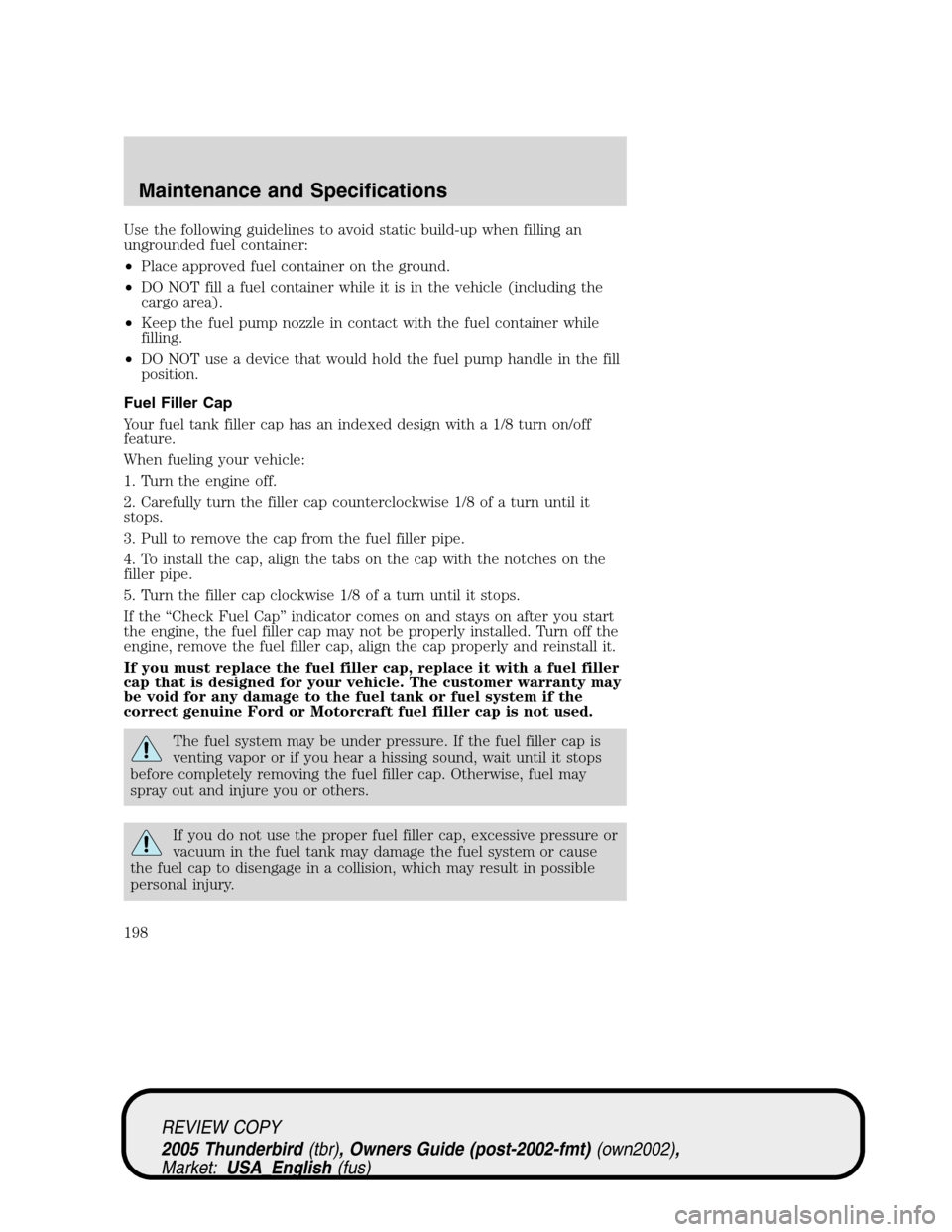
Use the following guidelines to avoid static build-up when filling an
ungrounded fuel container:
•Place approved fuel container on the ground.
•DO NOT fill a fuel container while it is in the vehicle (including the
cargo area).
•Keep the fuel pump nozzle in contact with the fuel container while
filling.
•DO NOT use a device that would hold the fuel pump handle in the fill
position.
Fuel Filler Cap
Your fuel tank filler cap has an indexed design with a 1/8 turn on/off
feature.
When fueling your vehicle:
1. Turn the engine off.
2. Carefully turn the filler cap counterclockwise 1/8 of a turn until it
stops.
3. Pull to remove the cap from the fuel filler pipe.
4. To install the cap, align the tabs on the cap with the notches on the
filler pipe.
5. Turn the filler cap clockwise 1/8 of a turn until it stops.
If the“Check Fuel Cap”indicator comes on and stays on after you start
the engine, the fuel filler cap may not be properly installed. Turn off the
engine, remove the fuel filler cap, align the cap properly and reinstall it.
If you must replace the fuel filler cap, replace it with a fuel filler
cap that is designed for your vehicle. The customer warranty may
be void for any damage to the fuel tank or fuel system if the
correct genuine Ford or Motorcraft fuel filler cap is not used.
The fuel system may be under pressure. If the fuel filler cap is
venting vapor or if you hear a hissing sound, wait until it stops
before completely removing the fuel filler cap. Otherwise, fuel may
spray out and injure you or others.
If you do not use the proper fuel filler cap, excessive pressure or
vacuum in the fuel tank may damage the fuel system or cause
the fuel cap to disengage in a collision, which may result in possible
personal injury.
REVIEW COPY
2005 Thunderbird(tbr), Owners Guide (post-2002-fmt)(own2002),
Market:USA_English(fus)
Maintenance and Specifications
198
Page 209 of 224
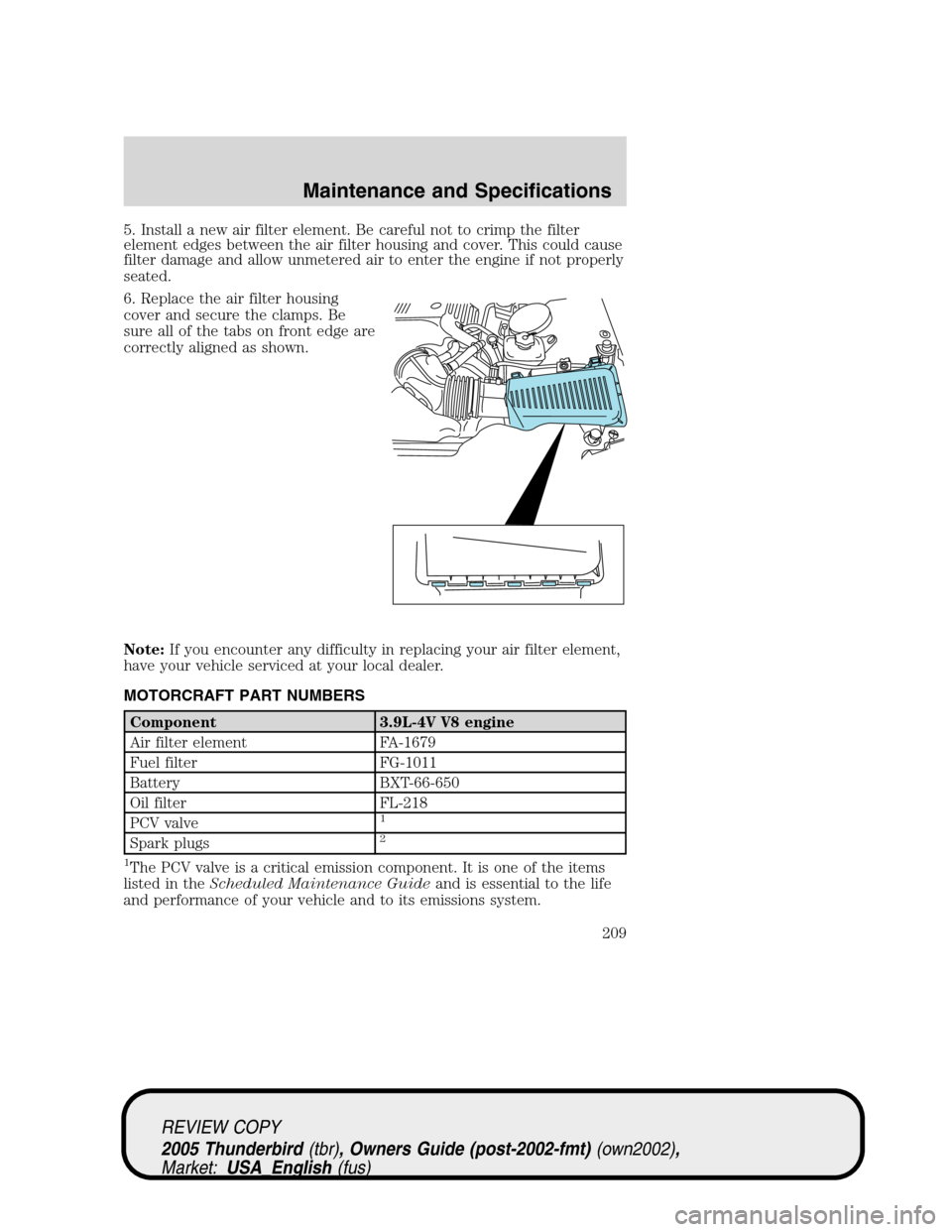
5. Install a new air filter element. Be careful not to crimp the filter
element edges between the air filter housing and cover. This could cause
filter damage and allow unmetered air to enter the engine if not properly
seated.
6. Replace the air filter housing
cover and secure the clamps. Be
sure all of the tabs on front edge are
correctly aligned as shown.
Note:If you encounter any difficulty in replacing your air filter element,
have your vehicle serviced at your local dealer.
MOTORCRAFT PART NUMBERS
Component 3.9L-4V V8 engine
Air filter element FA-1679
Fuel filter FG-1011
Battery BXT-66-650
Oil filter FL-218
PCV valve
1
Spark plugs2
1
The PCV valve is a critical emission component. It is one of the items
listed in theScheduled Maintenance Guideand is essential to the life
and performance of your vehicle and to its emissions system.
REVIEW COPY
2005 Thunderbird(tbr), Owners Guide (post-2002-fmt)(own2002),
Market:USA_English(fus)
Maintenance and Specifications
209
Page 219 of 224
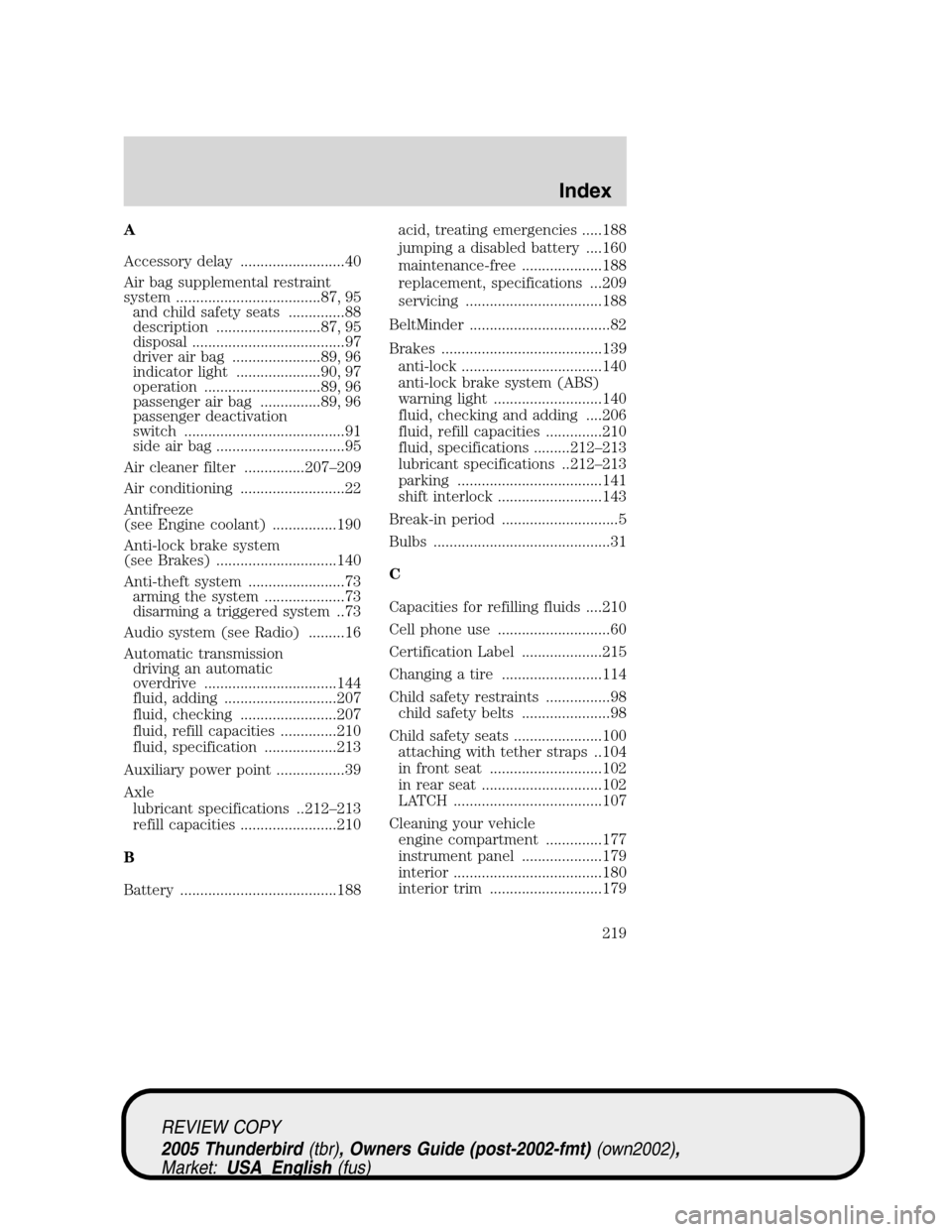
A
Accessory delay ..........................40
Air bag supplemental restraint
system ....................................87, 95
and child safety seats ..............88
description ..........................87, 95
disposal ......................................97
driver air bag ......................89, 96
indicator light .....................90, 97
operation .............................89, 96
passenger air bag ...............89, 96
passenger deactivation
switch ........................................91
side air bag ................................95
Air cleaner filter ...............207–209
Air conditioning ..........................22
Antifreeze
(see Engine coolant) ................190
Anti-lock brake system
(see Brakes) ..............................140
Anti-theft system ........................73
arming the system ....................73
disarming a triggered system ..73
Audio system (see Radio) .........16
Automatic transmission
driving an automatic
overdrive .................................144
fluid, adding ............................207
fluid, checking ........................207
fluid, refill capacities ..............210
fluid, specification ..................213
Auxiliary power point .................39
Axle
lubricant specifications ..212–213
refill capacities ........................210
B
Battery .......................................188acid, treating emergencies .....188
jumping a disabled battery ....160
maintenance-free ....................188
replacement, specifications ...209
servicing ..................................188
BeltMinder ...................................82
Brakes ........................................139
anti-lock ...................................140
anti-lock brake system (ABS)
warning light ...........................140
fluid, checking and adding ....206
fluid, refill capacities ..............210
fluid, specifications .........212–213
lubricant specifications ..212–213
parking ....................................141
shift interlock ..........................143
Break-in period .............................5
Bulbs ............................................31
C
Capacities for refilling fluids ....210
Cell phone use ............................60
Certification Label ....................215
Changing a tire .........................114
Child safety restraints ................98
child safety belts ......................98
Child safety seats ......................100
attaching with tether straps ..104
in front seat ............................102
in rear seat ..............................102
LATCH .....................................107
Cleaning your vehicle
engine compartment ..............177
instrument panel ....................179
interior .....................................180
interior trim ............................179
REVIEW COPY
2005 Thunderbird(tbr), Owners Guide (post-2002-fmt)(own2002),
Market:USA_English(fus)
Index
Index
219